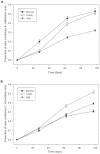Root foraging influences plant growth responses to earthworm foraging
- PMID: 25268503
- PMCID: PMC4182600
- DOI: 10.1371/journal.pone.0108873
Root foraging influences plant growth responses to earthworm foraging
Abstract
Interactions among the foraging behaviours of co-occurring animal species can impact population and community dynamics; the consequences of interactions between plant and animal foraging behaviours have received less attention. In North American forests, invasions by European earthworms have led to substantial changes in plant community composition. Changes in leaf litter have been identified as a critical indirect mechanism driving earthworm impacts on plants. However, there has been limited examination of the direct effects of earthworm burrowing on plant growth. Here we show a novel second pathway exists, whereby earthworms (Lumbricus terrestris L.) impact plant root foraging. In a mini-rhizotron experiment, roots occurred more frequently in burrows and soil cracks than in the soil matrix. The roots of Achillea millefolium L. preferentially occupied earthworm burrows, where nutrient availability was presumably higher than in cracks due to earthworm excreta. In contrast, the roots of Campanula rotundifolia L. were less likely to occur in burrows. This shift in root behaviour was associated with a 30% decline in the overall biomass of C. rotundifolia when earthworms were present. Our results indicate earthworm impacts on plant foraging can occur indirectly via physical and chemical changes to the soil and directly via root consumption or abrasion and thus may be one factor influencing plant growth and community change following earthworm invasion. More generally, this work demonstrates the potential for interactions to occur between the foraging behaviours of plants and soil animals and emphasizes the importance of integrating behavioural understanding in foraging studies involving plants.
Conflict of interest statement
Figures




Similar articles
-
Experimental evaluation of herbivory on live plant seedlings by the earthworm Lumbricus terrestris L. in the presence and absence of soil surface litter.PLoS One. 2015 Apr 17;10(4):e0123465. doi: 10.1371/journal.pone.0123465. eCollection 2015. PLoS One. 2015. PMID: 25885861 Free PMC article.
-
Patterns of litter disappearance in a northern hardwood forest invaded by exotic earthworms.Ecol Appl. 2006 Feb;16(1):154-65. doi: 10.1890/04-0788. Ecol Appl. 2006. PMID: 16705969
-
Effects of earthworms and white-tailed deer on roots, arbuscular mycorrhizae, and forest seedling performance.Ecology. 2020 Jan;101(1):e02903. doi: 10.1002/ecy.2903. Epub 2019 Nov 6. Ecology. 2020. PMID: 31563154
-
Ecological and evolutionary responses of earthworm holobionts to environmental changes.ISME J. 2025 Jan 2;19(1):wraf044. doi: 10.1093/ismejo/wraf044. ISME J. 2025. PMID: 40057975 Free PMC article. Review.
-
Research progress on earthworms and soil health.Ying Yong Sheng Tai Xue Bao. 2025 Feb 18;36(2):637-646. doi: 10.13287/j.1001-9332.202502.036. Ying Yong Sheng Tai Xue Bao. 2025. PMID: 40370181 Review. English.
Cited by
-
Do Invasive Earthworms Affect the Functional Traits of Native Plants?Front Plant Sci. 2021 Mar 16;12:627573. doi: 10.3389/fpls.2021.627573. eCollection 2021. Front Plant Sci. 2021. PMID: 33796124 Free PMC article.
-
Invasive earthworms can change understory plant community traits and reduce plant functional diversity.iScience. 2024 Jan 29;27(3):109036. doi: 10.1016/j.isci.2024.109036. eCollection 2024 Mar 15. iScience. 2024. PMID: 38361612 Free PMC article.
-
Mining the Drilosphere: Bacterial Communities and Denitrifier Abundance in a No-Till Wheat Cropping System.Front Microbiol. 2019 Jun 26;10:1339. doi: 10.3389/fmicb.2019.01339. eCollection 2019. Front Microbiol. 2019. PMID: 31316473 Free PMC article.
-
Arthropods as the Engine of Nutrient Cycling in Arid Ecosystems.Insects. 2021 Aug 14;12(8):726. doi: 10.3390/insects12080726. Insects. 2021. PMID: 34442292 Free PMC article. Review.
-
The unseen invaders: introduced earthworms as drivers of change in plant communities in North American forests (a meta-analysis).Glob Chang Biol. 2017 Mar;23(3):1065-1074. doi: 10.1111/gcb.13446. Epub 2016 Sep 3. Glob Chang Biol. 2017. PMID: 27590777 Free PMC article.
References
-
- Railsback SF, Harvey BC (2013) Trait-mediated trophic interactions: is foraging theory keeping up? Trends Ecol Evol 28: 119–125. - PubMed
-
- Hutchings MJ, de Kroon H (1994) Foraging in plants: the role of morphological plasticity in resource acquisition. Advances in Ecological Research 25: 159–238.
Publication types
MeSH terms
Substances
LinkOut - more resources
Full Text Sources
Other Literature Sources

